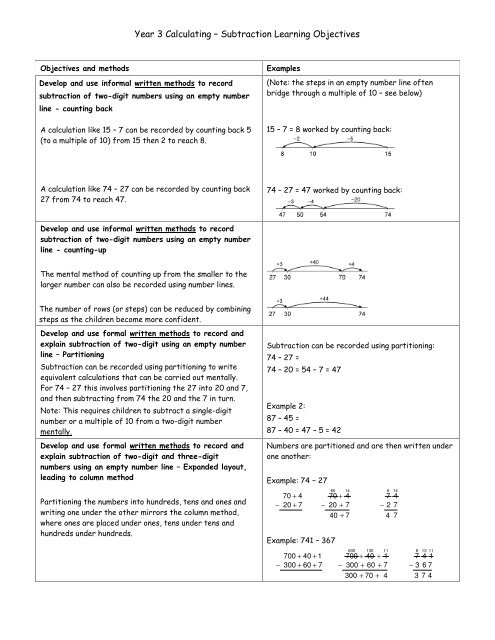Year 3 Calculating – Subtraction Learning Objectives
Year 3 Calculating – Subtraction Learning Objectives
Year 3 Calculating – Subtraction Learning Objectives
Create successful ePaper yourself
Turn your PDF publications into a flip-book with our unique Google optimized e-Paper software.
<strong>Year</strong> 3 <strong>Calculating</strong> <strong>–</strong> <strong>Subtraction</strong> <strong>Learning</strong> <strong>Objectives</strong><strong>Objectives</strong> and methodsDevelop and use informal written methods to recordsubtraction of two-digit numbers using an empty numberline - counting backA calculation like 15 <strong>–</strong> 7 can be recorded by counting back 5(to a multiple of 10) from 15 then 2 to reach 8.Examples(Note: the steps in an empty number line oftenbridge through a multiple of 10 <strong>–</strong> see below)15 <strong>–</strong> 7 = 8 worked by counting back:A calculation like 74 <strong>–</strong> 27 can be recorded by counting back27 from 74 to reach 47.74 <strong>–</strong> 27 = 47 worked by counting back:Develop and use informal written methods to recordsubtraction of two-digit numbers using an empty numberline - counting-upThe mental method of counting up from the smaller to thelarger number can also be recorded using number lines.The number of rows (or steps) can be reduced by combiningsteps as the children become more confident.Develop and use formal written methods to record andexplain subtraction of two-digit using an empty numberline <strong>–</strong> Partitioning<strong>Subtraction</strong> can be recorded using partitioning to writeequivalent calculations that can be carried out mentally.For 74 <strong>–</strong> 27 this involves partitioning the 27 into 20 and 7,and then subtracting from 74 the 20 and the 7 in turn.Note: This requires children to subtract a single-digitnumber or a multiple of 10 from a two-digit numbermentally.Develop and use formal written methods to record andexplain subtraction of two-digit and three-digitnumbers using an empty number line <strong>–</strong> Expanded layout,leading to column methodPartitioning the numbers into hundreds, tens and ones andwriting one under the other mirrors the column method,where ones are placed under ones, tens under tens andhundreds under hundreds.<strong>Subtraction</strong> can be recorded using partitioning:74 <strong>–</strong> 27 =74 <strong>–</strong> 20 = 54 <strong>–</strong> 7 = 47Example 2:87 <strong>–</strong> 45 =87 <strong>–</strong> 40 = 47 <strong>–</strong> 5 = 42Numbers are partitioned and are then written underone another:Example: 74 − 2760 14470 + 4 70 +6 147 4− 20 + 7 − 20 + 7 − 2 740 + 7 4 7Example: 741 − 367600 130700 + 40 + 111700 + 40 + 16 13 117 4 1− 300 + 60 + 7 − 300 + 60 + 7 − 3 6 7300 + 70 + 4 3 7 4
<strong>Year</strong> 3 <strong>Calculating</strong> <strong>–</strong> <strong>Subtraction</strong> <strong>Learning</strong> <strong>Objectives</strong>Mentally subtract combinations of one-digit and two-digitnumbers. <strong>–</strong> Building on Y2 work.To achieve this objective the children need to rehearse andrecall all addition facts to 10, known as number bonds (e.g.1+9, 2+8, 3+7, 4+6, 5+5) and subtraction facts to 10 (10-5=5,10-3=7, 10-9=1). They also need to begin to know all additionand subtraction facts to 20 (e.g. 12+8=20, 14+6=20, 16+4=20,20-4=16, 20-15=5).They also need rehearse and recall sums and differences ofmultiples of 10 e.g. to subtract multiples of 10 from othermultiples of 10 (e.g. 90-30=60). (Y2 objective)They need to know that subtraction means to take away.They need to be able to visualise the empty number line.Mentally subtracting combinations of one-digit and twodigitnumbers requires lots of practise and good knowledgeof the above number bonds.Understand subtraction as the inverse of addition. (Y2objective)This is particularly important in <strong>Year</strong> 3 as children are oftenstronger at addition than subtraction. If they understandsubtraction as the inverse of addition then they can turn thesum around to check their answer.Activity 1: Rehearse number bonds to 10 and writethem down (e.g. 1+9, 2 + 8, 3+7) Ask child to pick a 2-digit number (use a number square to help.)Whatnumber goes with the units to make 10? Use numberbonds to 10 to help.Activity 2: Make 0-10 number cards. Turn 2 cardsover to make a 2- digit number. Turn over one morecard and subtract the 1-digit number from the 2-digit number. How many can you get correct in 2minutes?Extension: make two 2-digit numbers and take thesmaller number away from the larger number.Activity 3: Bingo (needs 3+ players). Divide a pieceof paper into 9 boxes. Write a 1- or 2- digit numberbelow 30 in each box. One person make upsubtraction sums and the rest work out the answerand cross out the box if they have that number.Examples:7 <strong>–</strong> 3 = 4 This can be turned around: 4 + 3 = 767 <strong>–</strong> 33 = 34 This can be turned around: 34 + 33 = 6789 <strong>–</strong> 45 = 44 This can be turned around: 44 + 45 = 89


